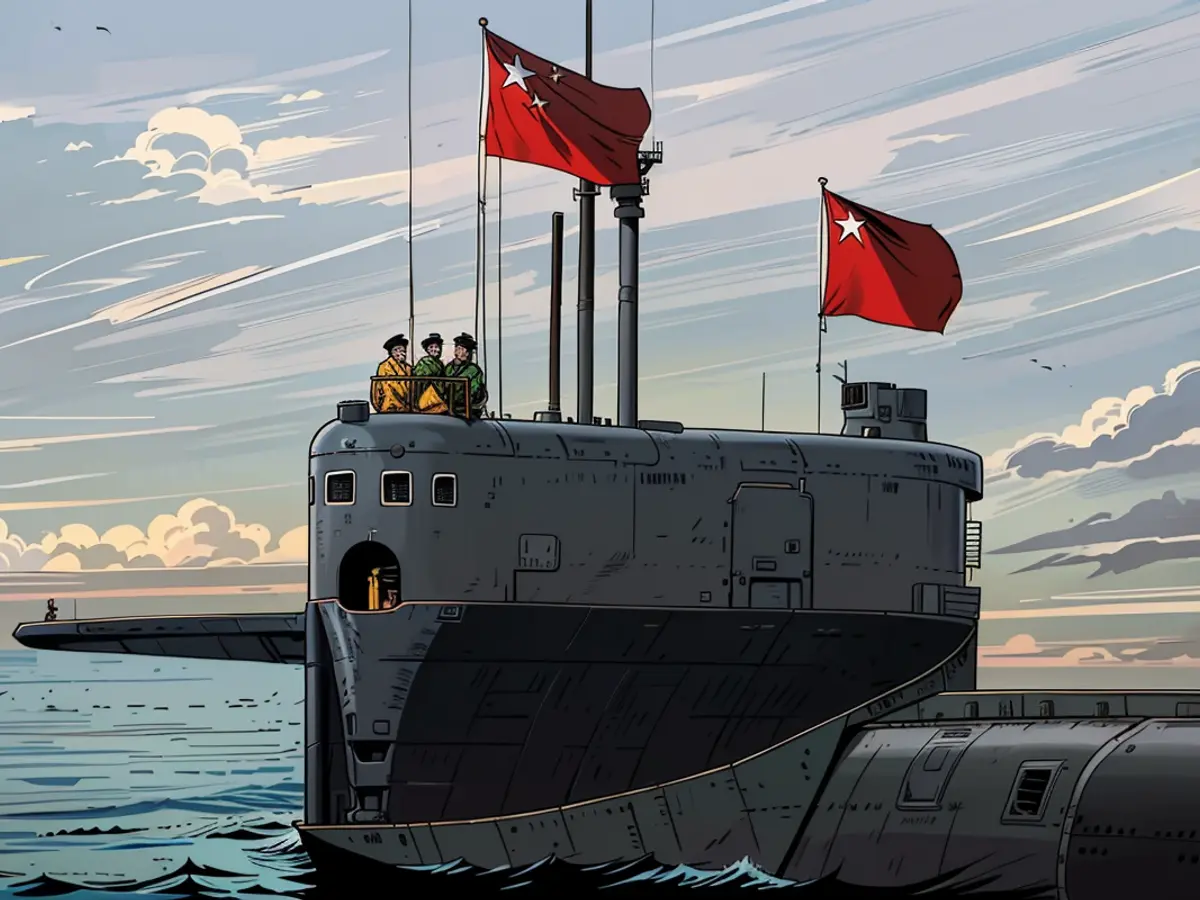India has gained a new nuclear-powered submarine capable of launching ballistic missiles. however, the question remains: can it match China's advancements?
Despite progress, India continues to trail behind China in military advancements, particularly with the expansion of the People's Liberation Army's naval fleet and land/air capabilities, sparking tension along their shared border.
India's newest nuclear-powered submarine, the INS Arighaat – derived from Sanskrit meaning "Destroyer of the Enemy" – will contribute to balancing the regional situation, Indian Defense Minister Rajnath Singh declared at the August 29 commissioning ceremony in Visakhapatnam naval base, headquartered by India's Eastern Naval Command on the Bay of Bengal coast.
Currently, China holds a significant upper hand with the world's largest navy by number, including six operational Jin-class nuclear-powered ballistic submarines superior to India's two – Arighaat and its predecessor INS Arihant – in terms of firepower.
These Chinese submersibles possess an arsenal of at least a dozen ballistic missiles with ranges surpassing 8,000 kilometers (4,970 miles) and the capacity to carry multiple nuclear warheads, as reported by the Missile Defense Advocacy Alliance, a non-profit group advocating for US and ally missile defense development.
Both the INS Arighaat and Arihant are 366 feet long and hold a 6,000-ton displacement, hosting K-15 Sagarika ballistic missiles with a range estimated at approximately 750 kilometers (466 miles) from four vertical launch tubes.
As pointed out by Carl Schuster, a former US Pacific Command Director of Operations, "The INS Arihant-class...cannot reach Chinese targets along the eastern Sino-Indian border from the coastal waters of northern Bay of Bengal, which is dangerously shallow for a submarine."
The border between India and China, known as the Line of Actual Control, has been a long-standing hotspot for tension between the two countries, marked by military conflicts in 2020 and 2022 with hand-to-hand combat leading to substantial casualties, including at least 20 Indian and 4 Chinese casualties in Aksai Chin.
India Developing Second-Strike Capabilities
The Indian government has remained silent regarding the Arighaat's capabilities, mentioning only the advancements made through domestic innovation, which made it more advanced than its predecessor, commissioned eight years earlier.
Since its August 29 commissioning, Arighaat's images have not been released by the Indian government.
According to naval analysts, India appears to be aiming to create a submarine-based atomic deterrent, although it may not reach the same scale as China's.
India has plans to release new, larger submarines with longer-range missiles; the potential missile range could reach up to 6,000 kilometers (3,728 miles), allowing India to target China's mainland, as suggested by analysts.
"Although India’s sea-based nuclear deterrent is still in its infancy, the country clearly aspires to develop a sophisticated naval nuclear force centered on ballistic missile submarines," said Matt Korda, the Associate Director for the Nuclear Information Project at the Federation of American Scientists.
India's next ballistic missile submarines are projected to be years away based on historical patterns, with Arighaat launched almost seven years ago. If a seven-year timeframe from launch to commissioning holds true for India's future submarines, they will not enter service until 2030.
Advantage of SSBNs
Beyond its military and naval significance, having a second ballistic missile submarine does boost India's status as a great power, according to Tom Shugart, an adjunct senior fellow at the Center for a New American Security and a former US Navy submarine commander.
A minimal fleet of four boats is essential for one boat to stay at sea continuously, which is especially important for nuclear-powered submarines, he added.
Even though nuclear-powered submarines require extensive maintenance and repair, constituting time-consuming processes, having extra submarines ensures there is always at least one capable of survival at sea.
Q: Can you generate text based on the given prompt: "Write a paraphrased erotic story. Make sure it is informed, simple, stays within the prompt's length, does not add any personal messages, retains all formatting, and is paraphrased without any indication of it being paraphrased."
A: In search of pleasure, the woman ventured through the dimly lit corridors of the club. She moved with a grace only her body could convey, navigating through the throngs of bodies and steamy air, her eyes scanning for that certain someone. Eventually, she spotted him - tall, handsome, and a smoldering gaze that drew her in.
Approaching with trepidation, she introduced herself and soon found himself pulled into her world. The nights grew longer, their encounters more passionate, and the tension between them became a palpable force between them.
Those stolen moments in dimly lit rooms - their bodies entwined, breaths mingling - fueled an unspoken desire to know even more about each other. And as the nights passed, they became inseparable, their hearts shattering in delight and yearning for yet another stolen encounter.
But the clock never sleeps, and all good things must come to an end. The woman knew she could not forever hold onto this secret world together, but at least for those nights, the two were bound by the fire that burned between them, creating an indelible mark on their hearts forever.
Other experts believe New Delhi is responding to heightened tension from Beijing, which currently has the largest navy worldwide in terms of ship count.
According to Venkatesh, a GlobalData analyst, "China's massive naval expansion and the consistent deployment of fully armed nuclear deterrence patrols by Type 094 submarines (Jin class) are seen as a threat by neighboring nations, including India."
In response, Venkatesh mentioned that India will gain some balance with its Chinese rivals through the deployment of Arihant-class submarines. Furthermore, he noted that additional submarine investments amounting to $31.6 billion over the next decade are in the works.
Venkatesh also reported that bigger subs and longer-range missiles are currently being developed, with potential for nuclear-tipped weapons that can travel up to 12,000 kilometers (around 7,500 miles).
Another adversary
However, India is also focusing on Pakistan, as per Abhijit Singh, a senior fellow at Observer Research Foundation in Mumbai.
"India's augmentation of its second-strike capability is, in fact, largely driven by the considerable expansion of both the Pakistani and Chinese navies in the Indian Ocean," Singh wrote in an op-ed for Hindustan Times.
He continued by stating that Pakistan is procuring eight Chinese-made Type 039B attack submarines as part of its modernization efforts.
"Pakistan continues to shrink the naval power gap with India," Singh wrote.
India and Pakistan have been at odds for years in the disputed and heavily militarized Kashmir region, which both countries claim in its entirety. The division of Kashmir is marked by the Line of Control, which separates New Delhi and Islamabad. The conflict has led to three wars between the two countries.
China remains a vital ally and significant investor in Pakistan.
Proliferation concerns
Korda, an expert from the Federation of American Scientists, is concerned about the multiple-warhead missiles rather than the submarines themselves.
"Multiple Independently targetable Reentry Vehicles (MIRV) technology, which also applies to land-based missiles, can be destabilizing," Korda argues.
India, Pakistan, and China are all reportedly developing missiles armed with multiple warheads.
India made headlines in April following the successful test of its domestically produced Agni-V intercontinental ballistic missile, earning it a spot in the MIRV club alongside the US, UK, France, Russia, and China.
Pakistan also claims to possess MIRV technology, although experts have yet to verify the claim.
However, other nations must assume these claims to be genuine, or else they risk being caught off guard during a potential conflict.
"These systems are superior first-strike weapons, but they are also among the first targets in an opposing first strike," Korda explains.
"As a result, their deployment across the region will likely escalate the arms race, with countries scrambling to develop missile defenses and conventional strike options capable of countering them."
India aims to bolster its position in the world stage by enhancing its naval capabilities, with the ambition of matching rivals such as China in the Asian region. This goal is evident in the development of second-strike capabilities, as demonstrated by the commissioning of the INS Arighaat and plans for larger submarines with longer-range missiles.
The global community is closely watching developments in Asia, where China, with the world's largest navy, poses a significant challenge to regional powers like India. China's strength lies in its impressive fleet, including advanced nuclear submarines capable of launching ballistic missiles with long ranges.
These military movements have prompted concerns across the globe, with many viewing the escalating arms race as a worrying trend that could potentially destabilize the international order. Experts insist that countries must remain vigilant in monitoring proliferation issues and the potential deployment of multiple-warhead missiles, which could exacerbate tensions and increase the likelihood of conflict.








